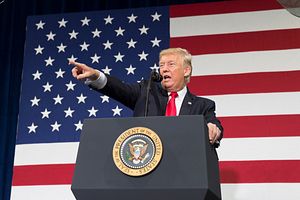U.S. President Donald J. Trump has chosen to herald the new year with a broadside against Pakistan on Twitter. “The United States has foolishly given Pakistan more than 33 billion dollars in aid over the last 15 years, and they have given us nothing but lies & deceit, thinking of our leaders as fools,” Trump said. “They give safe haven to the terrorists we hunt in Afghanistan, with little help. No more!”
The tweets are surprising in their timing, but not in their content. After a surprisingly rosy call as president-elect with former Pakistani Prime Minister Nawaz Sharif in the final days of 2016, shortly after his election victory, the Trump administration’s tone toward Pakistan has shifted. In late-August 2016, when Trump unveiled his new strategy toward Afghanistan, he didn’t mince words in condemning Pakistan. “It is time for Pakistan to demonstrate its commitment to civilization, order, and peace,” Trump noted in that speech.
It’s unclear just what exactly sparked Trump’s New Year’s Day broadside against Pakistan. In the days leading up to his latest outburst, the New York Times had reported that the U.S. Department of State may withhold a $255 million Foreign Military Financing (FMF) payment to Islamabad. As one observer speculated, the early morning timing of Trump’s tweet may suggest that something in his daily intelligence briefing may have sparked the outburst.
Trump’s turn against Islamabad might suggest something considerably serious that may have important implications for how the United States approaches Pakistan in 2018. While Trump delivered prepared remarks lambasting Islamabad’s record on counter-terrorism in August, he’d later come to take a softer tone. In October, he took to Twitter to note the following, for example: “Starting to develop a much better relationship with Pakistan and its leaders. I want to thank them for their cooperation on many fronts.” (The tweet came after the U.S.-assisted Pakistani operation to recuse a U.S. citizen and her Canadian husband who’d been held hostage by the Haqqani network for five years.)
Whatever presidential goodwill Pakistan won as a result of that operation may now be squandered and Trump’s views toward Pakistan may be more in line with those of his senior advisors, including Lisa Curtis, the senior director for South and Central Asia at the National Security Council. (Curtis, before her appointment to the position, released a report at the Heritage Foundation calling on the United States to cease viewing Pakistan as an ally unconditionally.)
As 2018 begins, the question will remain if this administration will be the one to turn bitter words against Pakistan into action. Former U.S. President Barack Obama, in his major 2009 speech on Afghanistan strategy, had similarly said harsh words against Islamabad, mentioning Pakistan more in his speech than Trump did, in fact. But over his year in office, despite various ups and downs, the United States did not take drastic action against Pakistan.
The menu of options available to the Trump administration with regard to Pakistan remains extensive. With Trump’s latest outburst, it would not be surprising if the United States withheld an FMF payment tranche. What would demonstrate serious is if Pakistani politicians and military officers would see U.S. sanctions put in place against them or if the United States formally repudiated Islamabad’s status as a major non-NATO ally. These actions won’t be without consequences. Since 2001, the United States has, to varying degrees, needed Pakistan’s cooperation to enable its military presence in Afghanistan, which is set to expand modestly under Trump’s plans.
For now, it remains to be seen where U.S.-Pakistan relations will go in 2018. We’ve seen U.S. presidents indulge in moments of frustration before, only for little to change. Trump, of course, isn’t like previous U.S. presidents, but it remains unclear if he’ll be the one to break the mold and chart a new course for U.S. ties with Pakistan.

































